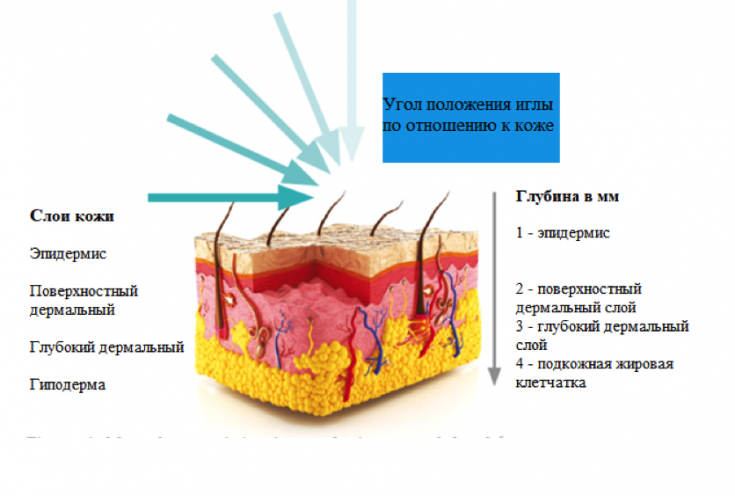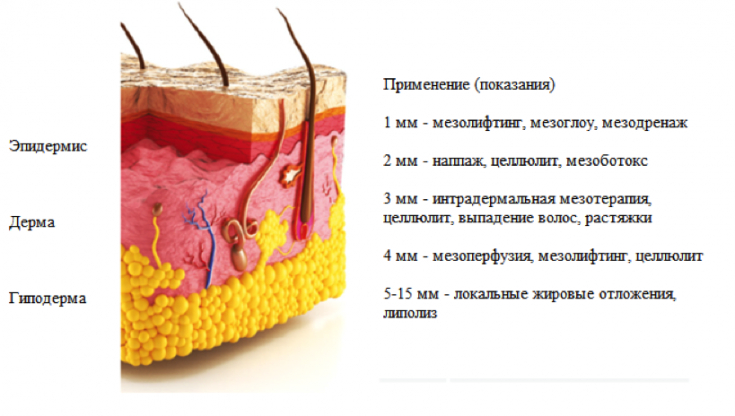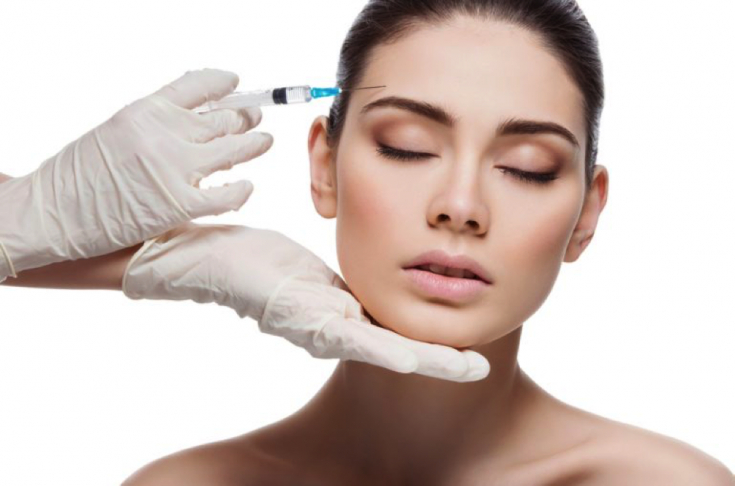Intradermal administration of small doses of active substances using fine needles is called mesotherapy. This minimally invasive procedure combines the benefits of microneedling with the power of ingredients delivered to the skin. The main goal of mesotherapy – stimulate the biosynthetic activity of fibroblasts and intercellular interaction, enhance the production of collagen and elastin. There are various techniques and preparations for mesotherapy, which are used to rejuvenate, stimulate hair growth, and reduce local fat deposits. This article estet-portal.com will focus on the use of mesotherapy in cosmetology for skin aging, hyper- or unwanted pigmentation, alopecia, acne, post-acne and cellulite.
- Four techniques for the administration of mesotherapy preparations
- Mesotherapy: indications, contraindications, side effects of the procedure
- Efficiency and features of mesotherapy for various indications
Four techniques for administering mesotherapy drugs
During mesotherapy, the doctor injects manually or with a mesoinjector that provides:
- more precise dosage;
- uniform insertion depth;
- higher injection speed and thus patient comfort.
In both cases, the doctor provides tension to the patient's skin with his free hand.
The literature describes 4 techniques for performing injections during mesotherapy, which allow you to control the speed of delivery of substances and their residence time in the tissues.
Needle insertion angle determines the depth of penetration.
The deeper the drug is injected, the faster its components are transported from the target area. More superficial injections provide longer residence of active ingredients in the skin. Deep and superficial injection techniques can be combined in one procedure and on one area of the body.
Injections ≥ 0.1 ml of the drug to a depth ≤ 1 mm leads to pastosity, which causes pain and disappears after a few hours.

Mesotherapy: techniques and depth of insertion
a number of factors, including:
target zone;- problem to be solved;
- injectable substance;
- pathology of the target area;
- skin conditions.
technique The epidermal mesotherapy technique does not cause bleeding and can be applied on large areas.
Depth of penetration – maximum 1 mm.
Dose of the drug for 1 prick – 0.01 ml.
Needle gauge – 27–31 G makes this technique virtually painless and ideal for sensitive areas such as around the eyes and lips. Drops of liquid on the surface of the skin are left until completely absorbed.
Nappage techniqueDepth of penetration – 1–4 mm.
Dose of the drug for 1 prick – 0.1 ml.
Needle Angle – 30–60 degrees.
Nappage – the most commonly used technique, which consists in making a series of injections at a distance of several millimeters under constant pressure.
Read also:How easy it is to master the nappage technique in mesotherapy
Point technologyDepth of penetration – 2–4mm.
Dose of the drug for 1 prick – less than 0.2 ml.
Injection points are spaced 2–10mm.
Important: On thin, delicate skin of the face, injection to a depth of 4 mm involves the risk of contact with blood vessels and even bone tissue. Therefore, the depth and angle of insertion must be corrected.

Infiltration technique
Depth of penetration – 4–12mm.
Dose of the drug for 1 prick – 0.5 mm.
Injection points are located at a distance of 5-10 mm.
For the reasons described above, it is not suitable for thin delicate skin, but is used to remove
excess fat and cellulite (lipolysis). Mesotherapy: indications, contraindications, side effects of the procedure
During the mesotherapy procedure, various
substances are administered as part of meso-cocktails. These include:
vitamins and minerals;- enzymes;
- hormones;
- drugs (such as vasodilators);
- plant extracts.
can be:
skin photodamage;- superficial wrinkles and lines;
- dryness and dull skin color;
- excessive or uneven pigmentation;
- alopecia;
- acne and post-acne;
- cellulite.
- There is no universal preparation for mesotherapy.
- Absolute:
- allergy or intolerance to the components of the meso-cocktail;
- predisposition to hypertrophic scars;
- history of keloid scars or scleroderma;
- epilepsy;
- acute bacterial or viral infections;
- serious cardiovascular or metabolic disease;
- taking warfarin or steroids;
- acute inflammatory skin diseases;
- autoimmune diseases;
- weakened immunity.
- Relative:
- taking aspirin or clopidorgel (before the procedure it is necessary to inform the patient about all the risks).
- Side effects of mesotherapy may occur due to the technique of administration or the drugs used.
How to increase the effectiveness of mesotherapy procedures
Non-specific side effects:nausea, vomiting;
- diarrhea;
- moderate pain;
- bleeding;
- skin sensitivity and itching;
- erythema;
- swelling;
- small hematomas;
- painful subcutaneous nodules at injection sites.
- As the depth of injection increases, the risk of hematomas increases. After mesotherapy, latent herpesvirus infections can be activated, which can be prevented with the help of appropriate drugs.
Adverse events after mesotherapy are rare if the procedure is performed by a qualified specialist and patients follow all the doctor's recommendations regarding preparation and post-procedure care.
After the procedure, patients are advised to limit for at least 48 hours:sun exposure;
- intense exercise;
- saunas.
- To avoid infection of the skin and soft tissues, only sterile
disposable materials should be used. Efficiency and features of mesotherapy for various indications
Because mesotherapy – a minimally invasive and gentle procedure, not all patients require
anesthetic creamduring the preparation phase, however, this method of anesthesia may be needed when working on sensitive areas of the forehead, around the eyes and mouth. Cool packs must be used to control reactive puffiness.
Mesotherapy for skin agingSkin aging is associated with dysfunction of dermal fibroblasts and a decrease in biosynthetic activity. Mesotherapy stimulates fibroblasts to produce hyaluronic acid, collagen and elastin. The active substances of mesococktails enhance this effect. The result of the procedure increases as the active substances are released over several weeks after the procedure.
Follow us on
Instagram! Epidermal
nappage and point mesotherapy(exposure depth – 1–2 mm) are recommended for use in all areas:
persons;- neck and décolletage;
- back of the hands.
A hyaluronic acid solution and an antioxidant complex with amino acids, vitamins and minerals, according to a 2015 study, activates the internal photoprotective mechanism and improves the quality of skin pigmentation. The 2019 study also demonstrated the effectiveness of vitamin C mesotherapy in the treatment of hyperpigmentation.

The purpose of mesotherapy for alopecia – to prolong the anagen phase, in which about 80% of the hair is at any time, stimulating and regenerating its roots.
Due to the low effectiveness of the procedure, mesotherapy is not recommended for patients with high autoimmune activity and with long-term alopecia.
There is evidence that platelet-rich plasma administered during mesotherapy significantly increases hair diameter and density.
To treat
alopecia lesionsit is recommended to use the epidermal nappage technique and point injection to a depth of 2–4 mm, the interval between injections – 1 see The maximum effect of mesotherapy does not appear immediately after injections, but after a course of procedures. In the future, regular maintenance procedures are required.
Mesotherapy for celluliteIn the treatment of cellulite, mesotherapy is carried out in the form of injection lipolysis. As a rule, the depth of injection increases, which allows the introduction of large volumes of substances. However, in this case, it is important to take into account the systemic effects of the ingredients, since if more than 20 ml of the substance is injected, the likelihood of its absorption increases.
Efficiency in removing fat depots was demonstrated by
phosphatidylzoline, aminophylline and hyaluronidase. A 2017 study demonstrated that mesotherapy reduces the appearance of cellulite, but the study was small scale.
Mesotherapy for acne and post-acneMesotherapy is not recommended for the treatment of active acne due to the presence of a bacterial infection in the skin, during the course of isotretinoin and for 18 months after its completion.
You may also be interested in:Case-based post-acne treatment Little studies are available on the use of mesotherapy for the treatment of post-acne. However, there is evidence of the effectiveness of microneedling (creating physical microchannels in the skin) as a technique in the fight against acne and post-acne. According to the results of the surveys, all patients report a decrease in the severity of scars after microneedling. However, further studies are required to evaluate the results of acne and post-acne treatment with mesotherapy.
Adapted from Aesthetics.
More interesting videos on our
YouTube-channel!






